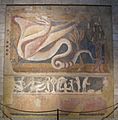Paintings from Arlanza facts for kids
The Arlanza paintings are amazing old wall paintings, called frescos, that used to decorate the monastery of San Pedro de Arlanza. This monastery is in Burgos Province, Castile and León, Spain. These paintings were made around the year 1210.
Over time, these beautiful artworks were taken down from the monastery walls and are now found in different museums and collections around the world. In the 1800s, the Spanish government started to remove and sell parts of these frescos. The biggest group of six large pieces was moved to the National Art Museum of Catalonia (MNAC) in Barcelona in 1943.
Most Romanesque art (art from around 1000 to 1200 AD) shows religious scenes. But the Arlanza paintings are special because they show animals and other non-religious subjects. This kind of art was rare in large monasteries like Arlanza. Experts like C. R. Dodwell have called these paintings "imposing" and say they show the "power and grandeur of Romanesque at its best."
Contents
What the Paintings Show
These paintings feature ten very large animals and other designs often seen in heraldry (symbols used by families or groups). They likely came from the chapter house or a room above it, in a part of the monastery called the Torre del Tesoro (Treasury Tower).
The artists were probably inspired by bestiaries, which were books filled with drawings and descriptions of real and imaginary animals. The paintings often have simple landscape backgrounds, just like those old books.
Famous Creatures
The group of paintings at the MNAC in Barcelona includes a gryphon. A gryphon is a mythical creature with the body of a lion and the head and wings of an eagle. This gryphon is shown in a watchful pose. The MNAC has five more pieces from this same collection.
Other parts of these paintings, like a lion and a dragon, are now at The Cloisters museum in New York. Another piece is at the Harvard University Fogg Art Museum, and one is in a private collection.
Art Style and Connections
The style of the Arlanza paintings is similar to other Spanish artworks from around 1200. They are especially like the frescos from the Monastery of Santa María de Sigena, which are also at the MNAC in Barcelona.
The Sigena frescos were clearly influenced by English illuminated manuscripts (beautifully decorated books). You can see this influence in the Arlanza paintings too, with their detailed and precise designs, even though they are very large. The Sigena frescos might even have been painted by English artists, possibly some of the same people who worked on the famous Winchester Bible. Interestingly, the Sigena frescos also feature a very similar gryphon and lion, suggesting the same main artist might have worked on both sets of paintings.
Some of the Arlanza pieces in New York still have a black and white frieze (a long, narrow band of decoration) below the large colorful animals. This frieze shows more figures, including other fantastic beasts.
Images for kids
-
An old symbol of the Kingdom of Castile, now at MNAC.
-
An old symbol of the Kingdom of León, now in New York.
See also
 In Spanish: Pinturas de San Pedro de Arlanza para niños
In Spanish: Pinturas de San Pedro de Arlanza para niños







